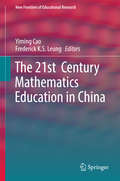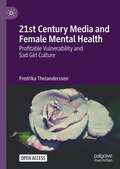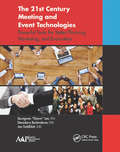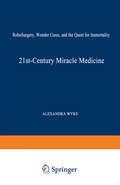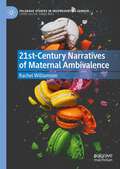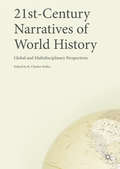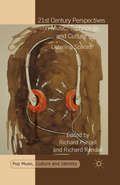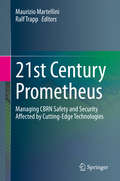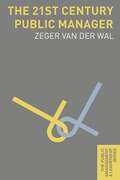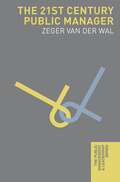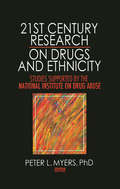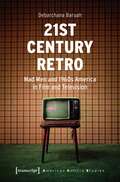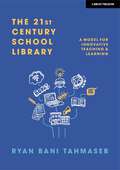- Table View
- List View
The 21st Century Mathematics Education in China (New Frontiers of Educational Research)
by Yiming Cao Frederick K.S. LeungThis book intends to provide a comprehensive introduction to the status of development of Chinese mathematics education in the 21st century. To this end, the book summarizes and presents the research and practices of Chinese mathematics education in the following aspects: (1) characteristics of Chinese school mathematics curriculum and textbooks, (2) Chinese ways and strategies of teaching mathematics and the characteristics of mathematics classroom instruction in China, (3) Chinese instructional practices in developing (both gifted and underachieving) students’ mathematical capabilities, (4) how professional development of mathematics teachers is promoted in China, including mathematics teachers’ pre-service and in-service education, and how Chinese mathematics teachers design and implement teaching and research activities, and (5) how mathematics education is assessed and evaluated, including how to evaluate teachers’ teaching and students’ achievements. Relevant research in Chinese mathematics education involving methods of surveys, interviews, text analysis, etc., are reviewed and analyzed. Results of a number of video studies of Chinese mathematics classroom teaching and learning are also integrated into this book.
21st Century Media and Female Mental Health: Profitable Vulnerability and Sad Girl Culture
by Fredrika ThelanderssonThis open access book examines the conversations around gendered mental health in contemporary Western media culture. While early 21st century-media was marked by a distinct focus on happiness, productivity and success, during the 2010s negative feelings and discussions around mental health have become increasingly common in that same media landscape. This book traces this turn to sadness in women’s media culture and shows that it emerged indirectly as a result of a culture overtly focused on happiness. By tracing the coverage of mental health issues in magazines, among female celebrities, and on social media this book shows how an increasingly intimate media environment has made way for a profitable vulnerability, that takes the shape of marketable and brand-friendly mental illness awareness that strengthens the authenticity of those who embrace it. But at the same time sad girl cultures are proliferating on social media platforms, creating radically honest spaces where those who suffer get support, and more capacious ways of feeling bad are formed. Using discourse analysis and digital ethnography to study contemporary representations of mental illness and sadness in Western popular media and social media, this book takes a feminist media studies approach to popular discourse, understanding the conversations happening around mental health in these sites to function as scripts for how to think about and experience mental illness and sadness
The 21st Century Meeting and Event Technologies: Powerful Tools for Better Planning, Marketing, and Evaluation
by Seungwon "Shawn" Lee Dessislava Boshnakova Joe GoldblattHere is the first book to specifically and comprehensively address the rapid changes and advances in technology in the planning, management, and marketing of meetings and events. The multigenerational trio of authors, including Joe Goldblatt and two of his former students, Seungwon "Shawn" Lee and Dessislava Boshnakova, cover the most important aspects of using technology for today’s meetings and events, such asHow to harness the power of social mediaHow to use crowdsourcing effectivelyHow to choose appropriate room layout design softwareHow to manage and use guest-generated contentHow to measure and evaluate your successHow to choose meeting registration softwareHow to promote your meeting with blogs, websites, podcasts, and moreHow to hold virtual meetings and eventsHow to use search engine optimization to advantage The area of meeting and event technology is a fast-growing component of the meetings, incentives, conventions and exhibition (MICE) industry. With a foreword by Corbin Ball, an internationally renowned speaker, consultant and writer in the meetings and events technology field, The 21st Century Meeting and Event Technologies will be an essential resource for hospitality students and business professionals.Faculty may request an examination copy from info@appleacademicpress.com. Please provide your name and title, course title, course start date, current text, number of students, and your institution address.
The 21st Century Meeting and Event Technologies: Powerful Tools for Better Planning, Marketing, and Evaluation
by Seungwon "Shawn" Lee Dessislava Boshnakova Joe GoldblattHere is the first book to specifically and comprehensively address the rapid changes and advances in technology in the planning, management, and marketing of meetings and events. The multigenerational trio of authors, including Joe Goldblatt and two of his former students, Seungwon "Shawn" Lee and Dessislava Boshnakova, cover the most important aspects of using technology for today’s meetings and events, such asHow to harness the power of social mediaHow to use crowdsourcing effectivelyHow to choose appropriate room layout design softwareHow to manage and use guest-generated contentHow to measure and evaluate your successHow to choose meeting registration softwareHow to promote your meeting with blogs, websites, podcasts, and moreHow to hold virtual meetings and eventsHow to use search engine optimization to advantage The area of meeting and event technology is a fast-growing component of the meetings, incentives, conventions and exhibition (MICE) industry. With a foreword by Corbin Ball, an internationally renowned speaker, consultant and writer in the meetings and events technology field, The 21st Century Meeting and Event Technologies will be an essential resource for hospitality students and business professionals.Faculty may request an examination copy from info@appleacademicpress.com. Please provide your name and title, course title, course start date, current text, number of students, and your institution address.
21st-Century Miracle Medicine: RoboSurgery, Wonder Cures, and the Quest for Immortality
by Alexandra WykeThe future of healthcare may be very simple. You will sit in your living room chair and drink your tea, coffee, and beer. As you sip, the chair will absorb an encyclopedia of knowledge about your physical state of affairs. A life-management computer in your kitchen will integrate the data and then display it for you on your watch face. A daily physical work-up precisely tailored to your body will pop up on the display, showing you what you have to do over the next 24 hours to avoid all the major disease processes currently plaguing the world. This comprehensive data bank will draw on all the world's medical databases, which have been integrated to help you prevent disease. You will rise from your chair and undertake an exact modicum of exercise tailored to your requirements, performing proscribed activities that will build your stamina precisely based on your "chair data. " The health status-monitoring sweatshirt that you wear during exercise will continue its analysis throughout the day. Your diet will be calibrated from your medical database, which vii viii 21st-CENTURY MIRACLE MEDICINE will be stored in a now-common bathroom appliance, the special preventive care server. In fact, clothed in your own domestic decor, the home will become the most sophisticated medical center in the world. All you have to do is keep going, as medicine becomes an invisible service, and your life will be effortlessly extended ten to twenty years.
21st Century Nanoscience: A Handbook (Ten-Volume Set) (21st Century Nanoscience)
by Klaus D. SattlerThis 21st Century Nanoscience Handbook will be the most comprehensive, up-to-date large reference work for the field of nanoscience. Handbook of Nanophysics, by the same editor, published in the fall of 2010, was embraced as the first comprehensive reference to consider both fundamental and applied aspects of nanophysics. This follow-up project has been conceived as a necessary expansion and full update that considers the significant advances made in the field since 2010. It goes well beyond the physics as warranted by recent developments in the field. Key Features: Provides the most comprehensive, up-to-date large reference work for the field. Chapters written by international experts in the field. Emphasises presentation and real results and applications. This handbook distinguishes itself from other works by its breadth of coverage, readability and timely topics. The intended readership is very broad, from students and instructors to engineers, physicists, chemists, biologists, biomedical researchers, industry professionals, governmental scientists, and others whose work is impacted by nanotechnology. It will be an indispensable resource in academic, government, and industry libraries worldwide. The fields impacted by nanoscience extend from materials science and engineering to biotechnology, biomedical engineering, medicine, electrical engineering, pharmaceutical science, computer technology, aerospace engineering, mechanical engineering, food science, and beyond.
21st Century Nanoscience – A Handbook: Nanophysics Sourcebook (Volume One) (21st Century Nanoscience)
by Klaus D. SattlerThis up-to-date reference is the most comprehensive summary of the field of nanoscience and its applications. It begins with fundamental properties at the nanoscale and then goes well beyond into the practical aspects of the design, synthesis, and use of nanomaterials in various industries. It emphasizes the vast strides made in the field over the past decade – the chapters focus on new, promising directions as well as emerging theoretical and experimental methods. The contents incorporate experimental data and graphs where appropriate, as well as supporting tables and figures with a tutorial approach.
21st Century Nanoscience – A Handbook: Nanophysics Sourcebook (Volume One) (21st Century Nanoscience)
by Klaus D. SattlerThis up-to-date reference is the most comprehensive summary of the field of nanoscience and its applications. It begins with fundamental properties at the nanoscale and then goes well beyond into the practical aspects of the design, synthesis, and use of nanomaterials in various industries. It emphasizes the vast strides made in the field over the past decade – the chapters focus on new, promising directions as well as emerging theoretical and experimental methods. The contents incorporate experimental data and graphs where appropriate, as well as supporting tables and figures with a tutorial approach.
21st Century Nanoscience – A Handbook: Design Strategies for Synthesis and Fabrication (Volume Two) (21st Century Nanoscience)
by Klaus D. SattlerThis up-to-date reference is the most comprehensive summary of the field of nanoscience and its applications. It begins with fundamental properties at the nanoscale and then goes well beyond into the practical aspects of the design, synthesis, and use of nanomaterials in various industries. It emphasizes the vast strides made in the field over the past decade – the chapters focus on new, promising directions as well as emerging theoretical and experimental methods. The contents incorporate experimental data and graphs where appropriate, as well as supporting tables and figures with a tutorial approach.
21st Century Nanoscience – A Handbook: Bioinspired Systems and Methods (Volume Seven) (21st Century Nanoscience)
by Klaus D. SattlerThis 21st Century Nanoscience Handbook will be the most comprehensive, up-to-date large reference work for the field of nanoscience. Handbook of Nanophysics by the same editor published in the fall of 2010 and was embraced as the first comprehensive reference to consider both fundamental and applied aspects of nanophysics. This follow-up project has been conceived as a necessary expansion and full update that considers the significant advances made in the field since 2010. It goes well beyond the physics as warranted by recent developments in the field. This seventh volume in a ten-volume set covers bioinspired systems and methods. Key Features: Provides the most comprehensive, up-to-date large reference work for the field. Chapters written by international experts in the field. Emphasises presentation and real results and applications. This handbook distinguishes itself from other works by its breadth of coverage, readability and timely topics. The intended readership is very broad, from students and instructors to engineers, physicists, chemists, biologists, biomedical researchers, industry professionals, governmental scientists, and others whose work is impacted by nanotechnology. It will be an indispensable resource in academic, government, and industry libraries worldwide. The fields impacted by nanophysics extend from materials science and engineering to biotechnology, biomedical engineering, medicine, electrical engineering, pharmaceutical science, computer technology, aerospace engineering, mechanical engineering, food science, and beyond.
21st Century Nanoscience – A Handbook: Bioinspired Systems and Methods (Volume Seven) (21st Century Nanoscience)
by Klaus D. SattlerThis 21st Century Nanoscience Handbook will be the most comprehensive, up-to-date large reference work for the field of nanoscience. Handbook of Nanophysics by the same editor published in the fall of 2010 and was embraced as the first comprehensive reference to consider both fundamental and applied aspects of nanophysics. This follow-up project has been conceived as a necessary expansion and full update that considers the significant advances made in the field since 2010. It goes well beyond the physics as warranted by recent developments in the field. This seventh volume in a ten-volume set covers bioinspired systems and methods. Key Features: Provides the most comprehensive, up-to-date large reference work for the field. Chapters written by international experts in the field. Emphasises presentation and real results and applications. This handbook distinguishes itself from other works by its breadth of coverage, readability and timely topics. The intended readership is very broad, from students and instructors to engineers, physicists, chemists, biologists, biomedical researchers, industry professionals, governmental scientists, and others whose work is impacted by nanotechnology. It will be an indispensable resource in academic, government, and industry libraries worldwide. The fields impacted by nanophysics extend from materials science and engineering to biotechnology, biomedical engineering, medicine, electrical engineering, pharmaceutical science, computer technology, aerospace engineering, mechanical engineering, food science, and beyond.
21st Century Nanoscience – A Handbook: Nanophotonics, Nanoelectronics, and Nanoplasmonics (Volume Six) (21st Century Nanoscience)
by Klaus D. Sattler21st Century Nanoscience - A Handbook: Nanophotonics, Nanoelectronics, and Nanoplasmonics (Volume 6) will be the most comprehensive, up-to-date large reference work for the field of nanoscience. Handbook of Nanophysics by the same editor published in the fall of 2010 and was embraced as the first comprehensive reference to consider both fundamental and applied aspects of nanophysics. This follow-up project has been conceived as a necessary expansion and full update that considers the significant advances made in the field since 2010. It goes well beyond the physics as warranted by recent developments in the field. This sixth volume in a ten-volume set covers nanophotonics, nanoelectronics, and nanoplasmonics. Key Features: Provides the most comprehensive, up-to-date large reference work for the field. Chapters written by international experts in the field. Emphasises presentation and real results and applications. This handbook distinguishes itself from other works by its breadth of coverage, readability and timely topics. The intended readership is very broad, from students and instructors to engineers, physicists, chemists, biologists, biomedical researchers, industry professionals, governmental scientists, and others whose work is impacted by nanotechnology. It will be an indispensable resource in academic, government, and industry libraries worldwide. The fields impacted by nanophysics extend from materials science and engineering to biotechnology, biomedical engineering, medicine, electrical engineering, pharmaceutical science, computer technology, aerospace engineering, mechanical engineering, food science, and beyond.
21st Century Nanoscience – A Handbook: Nanophotonics, Nanoelectronics, and Nanoplasmonics (Volume Six) (21st Century Nanoscience)
by Klaus D. Sattler21st Century Nanoscience - A Handbook: Nanophotonics, Nanoelectronics, and Nanoplasmonics (Volume 6) will be the most comprehensive, up-to-date large reference work for the field of nanoscience. Handbook of Nanophysics by the same editor published in the fall of 2010 and was embraced as the first comprehensive reference to consider both fundamental and applied aspects of nanophysics. This follow-up project has been conceived as a necessary expansion and full update that considers the significant advances made in the field since 2010. It goes well beyond the physics as warranted by recent developments in the field. This sixth volume in a ten-volume set covers nanophotonics, nanoelectronics, and nanoplasmonics. Key Features: Provides the most comprehensive, up-to-date large reference work for the field. Chapters written by international experts in the field. Emphasises presentation and real results and applications. This handbook distinguishes itself from other works by its breadth of coverage, readability and timely topics. The intended readership is very broad, from students and instructors to engineers, physicists, chemists, biologists, biomedical researchers, industry professionals, governmental scientists, and others whose work is impacted by nanotechnology. It will be an indispensable resource in academic, government, and industry libraries worldwide. The fields impacted by nanophysics extend from materials science and engineering to biotechnology, biomedical engineering, medicine, electrical engineering, pharmaceutical science, computer technology, aerospace engineering, mechanical engineering, food science, and beyond.
21st Century Nanoscience – A Handbook: Design Strategies for Synthesis and Fabrication (Volume Two) (21st Century Nanoscience)
by Klaus D. SattlerThis up-to-date reference is the most comprehensive summary of the field of nanoscience and its applications. It begins with fundamental properties at the nanoscale and then goes well beyond into the practical aspects of the design, synthesis, and use of nanomaterials in various industries. It emphasizes the vast strides made in the field over the past decade – the chapters focus on new, promising directions as well as emerging theoretical and experimental methods. The contents incorporate experimental data and graphs where appropriate, as well as supporting tables and figures with a tutorial approach.
21st-Century Narratives of Maternal Ambivalence (Palgrave Studies in (Re)Presenting Gender)
by Rachel WilliamsonMotherhood has long been depicted in reductive or limited terms. At once valorized and configured as the ultimate end-goal for socially condoned femininity, maternity is also highly mediated and scrutinized. This has resulted in a representational tradition that persists in imagining maternal subjects in rigid binary terms, pitting good mothers against bad. Largely in response to this repressive schema, recent years have marked the emergence of a diverse range of visual and literary texts about motherhood. While such texts vary in style, genre and form, this book argues that they are unified in their efforts to publicize embodied maternal experience and foreground maternal ambivalence, a concept that is best understood as a mother’s capacity to simultaneously love and hate her child. Although maternal ambivalence has become an increasingly popular topic of study with maternal scholars, its articulation within contemporary representations and narratives has yet to be adequately theorized and addressed, and this book aims to fill this gap.
21st-Century Narratives of World History: Global and Multidisciplinary Perspectives
by R. Charles WellerThis book makes a unique and timely contribution to world/global historical studies and related fields. It places essential world historical frameworks by top scholars in the field today in clear, direct relation to and conversation with one other, offering them opportunity to enrich, elucidate and, at times, challenge one another. It thereby aims to: (1) offer world historians opportunity to critically reflect upon and refine their essential interpretational frameworks, (2) facilitate more effective and nuanced teaching and learning in and beyond the classroom, (3) provide accessible world historical contexts for specialized areas of historical as well as other fields of research in the humanities, social sciences and sciences, and (4) promote comparative historiographical critique which (a) helps identify continuing research questions for the field of world history in particular, as well as (b) further global peace and dialogue in relation to varying views of our ever-increasingly interconnected, interdependent, multicultural, and globalized world and its shared though diverse and sometimes contested history.
21st-Century Narratives of World History: Global and Multidisciplinary Perspectives
by R. Charles WellerThis book makes a unique and timely contribution to world/global historical studies and related fields. It places essential world historical frameworks by top scholars in the field today in clear, direct relation to and conversation with one other, offering them opportunity to enrich, elucidate and, at times, challenge one another. It thereby aims to: (1) offer world historians opportunity to critically reflect upon and refine their essential interpretational frameworks, (2) facilitate more effective and nuanced teaching and learning in and beyond the classroom, (3) provide accessible world historical contexts for specialized areas of historical as well as other fields of research in the humanities, social sciences and sciences, and (4) promote comparative historiographical critique which (a) helps identify continuing research questions for the field of world history in particular, as well as (b) further global peace and dialogue in relation to varying views of our ever-increasingly interconnected, interdependent, multicultural, and globalized world and its shared though diverse and sometimes contested history.
21st Century Perspectives on Music, Technology, and Culture: Listening Spaces (Pop Music, Culture and Identity)
by R. Purcell R. RandallThis collection presents a contemporary evaluation of the changing structures of music delivery and enjoyment. Exploring the confluence of music consumption, burgeoning technology, and contemporary culture; this volume focuses on issues of musical communities and the politics of media.
21st Century Prometheus: Managing CBRN Safety and Security Affected by Cutting-Edge Technologies
by Maurizio Martellini Ralf TrappThis book describes the evolving CBRN risk landscape and highlights advances in the “core” CBRN technologies, including when combined with (improvised) explosive devices (CBRNe threats). It analyses how associated technologies create new safety and security risks, challenging certain assumptions that underlie current control regimes. The book also shows how technologies can be enablers for more effective strategies to mitigate these risks.21st-century safety and security risks emanating from chemical, biological, radiological and nuclear materials – whether resulting from natural events, accidents or malevolent use - are increasingly shaped by technologies that enable their development, production or use in ways that differ from the past. Artificial intelligence, the use of cyberspace, the revolution in the life sciences, new manufacturing methods, new platforms and equipment for agent delivery, hypersonic weapons systems, information tools utilised in hybrid warfare – these and other technologies are reshaping the global security environment and CBRN landscape. They are leading to a growing potential for highly targeted violence, and they can lead to greater instability and vulnerability worldwide. At the same time, technology offers solutions to manage CBRN risks. Examples are faster detection, more accurate characterisation of the nature and origin of CBRN agents, new forensic investigation methods, or new medical treatments for victims of CBRN incidents. New educational concepts help to foster a culture of responsibility in science and technology and strengthen governance. New training methods help develop practical skills to manage CBRN risks more effectively.The book concludes that there is a growing need for a holistic framework towards CBRN risk mitigation. Traditional arms control mechanisms such as global, regional or bilateral treaties and export controls are still needed, as they provide a necessary legal and institutional framework. But laws and technology denial alone will not suffice, and institutional mechanisms can at times be weak. Given the pace of technological progress and the diffusion of critical knowledge, tools and materials, policymakers must accept that CBRN risks cannot be eliminated altogether. Instead, society has to learn to manage these risks and develop resilience against them. This requires a “softer”, broadly based multi-stakeholder approach involving governments, industry, the research and development communities, educators, and civil society. Furthermore, educating policymakers that cutting-edge technologies may seriously affect global strategic stability could create incentives for developing a more creative and contemporary arms control strategy that fosters cooperation rather than incremental polarisation.
The 21st Century Public Manager (The Public Management and Leadership Series)
by Zeger Van WalTruly global in scope and ambition, the 21st Century Public Manager addresses key trends, challenges, and opportunities facing public managers across contexts and regimes. This accessible textbook aims to inspire public managers in rethinking their roles, skills, and values as they enter a VUCA world-one characterized by volatility, uncertainty, complexity, and ambiguity. It is written for aspiring and current public managers in graduate schools and executive education programs.
The 21st Century Public Manager (The Public Management and Leadership Series)
by Zeger van der WalTruly global in scope and ambition, the 21st Century Public Manager addresses key trends, challenges, and opportunities facing public managers across contexts and regimes. This accessible textbook aims to inspire public managers in rethinking their roles, skills, and values as they enter a VUCA world—one characterized by volatility, uncertainty, complexity, and ambiguity. It is written for aspiring and current public managers in graduate schools and executive education programs.
21st Century Research on Drugs and Ethnicity: Studies Supported by the National Institute on Drug Abuse
by Peter L. MyersLearn about the latest federally supported research on ethnicity and drug use The National Institute on Drug Abuse has supported professional research into variation among ethnic groups&’ use, abuse, and recovery from alcohol, tobacco, and other drugs, as well as research into perceptions of and readiness for treatment. 21st Century Research on Drugs and Ethnicity: Studies Supported by the National Institute on Drug Abuse takes a detailed look at the research performed in the last three years to help provide evidence-based and culturally competent counseling and treatment for individuals suffering from substance abuse/addiction syndromes. Top researchers discuss crucial unique issues in ethnic group use of psychoactive substances. This valuable resource explores the studies to better enable treatment, counseling, and prevention personnel who work in treatment programs, community groups, and schools to provide effective evidence-based practices tailored to the population they serve. 21st Century Research on Drugs and Ethnicity: Studies Supported by the National Institute on Drug Abuse presents prominent researchers such as J. Scott Tonigan, William Miller, and Mario de la Rosa who reveal and discuss the latest important data. This volume can be used by practitioners to increase the rates of individuals making healthy choices, or recovering from and sustaining recovery from abuse syndromes. The book also includes an introduction by Lula Beatty, PhD, Chief of the Special Populations Office at the National Institute on Drug Abuse. Topics discussed in 21st Century Research on Drugs and Ethnicity: Studies Supported by the National Institute on Drug Abuse include: a comparison of professional models of treatment readiness analysis of how client culture matches treatment culture Native American client response to modern treatment modalities research on current rates of drug use among racial/ethnic groups at colleges study into injecting drug use behaviors problems of treatment underutilization by Latinos/Latinas and much more! 21st Century Research on Drugs and Ethnicity: Studies Supported by the National Institute on Drug Abuse is a valuable resource for human service workers, psychologists, social workers, addictions researchers, educators, trainers, treatment personnel, and graduate students in counseling, social work, health, and addictions.
21st Century Research on Drugs and Ethnicity: Studies Supported by the National Institute on Drug Abuse
by Peter L. MyersLearn about the latest federally supported research on ethnicity and drug use The National Institute on Drug Abuse has supported professional research into variation among ethnic groups&’ use, abuse, and recovery from alcohol, tobacco, and other drugs, as well as research into perceptions of and readiness for treatment. 21st Century Research on Drugs and Ethnicity: Studies Supported by the National Institute on Drug Abuse takes a detailed look at the research performed in the last three years to help provide evidence-based and culturally competent counseling and treatment for individuals suffering from substance abuse/addiction syndromes. Top researchers discuss crucial unique issues in ethnic group use of psychoactive substances. This valuable resource explores the studies to better enable treatment, counseling, and prevention personnel who work in treatment programs, community groups, and schools to provide effective evidence-based practices tailored to the population they serve. 21st Century Research on Drugs and Ethnicity: Studies Supported by the National Institute on Drug Abuse presents prominent researchers such as J. Scott Tonigan, William Miller, and Mario de la Rosa who reveal and discuss the latest important data. This volume can be used by practitioners to increase the rates of individuals making healthy choices, or recovering from and sustaining recovery from abuse syndromes. The book also includes an introduction by Lula Beatty, PhD, Chief of the Special Populations Office at the National Institute on Drug Abuse. Topics discussed in 21st Century Research on Drugs and Ethnicity: Studies Supported by the National Institute on Drug Abuse include: a comparison of professional models of treatment readiness analysis of how client culture matches treatment culture Native American client response to modern treatment modalities research on current rates of drug use among racial/ethnic groups at colleges study into injecting drug use behaviors problems of treatment underutilization by Latinos/Latinas and much more! 21st Century Research on Drugs and Ethnicity: Studies Supported by the National Institute on Drug Abuse is a valuable resource for human service workers, psychologists, social workers, addictions researchers, educators, trainers, treatment personnel, and graduate students in counseling, social work, health, and addictions.
21st Century Retro: Mad Men and 1960s America in Film and Television (American Culture Studies #32)
by Debarchana BaruahNumerous contemporary televisual productions revisit the past but direct their energies towards history's non-events and anti-heroic subjectivities. Debarchana Baruah offers a vocabulary to discuss these, using Mad Men as a primary case study and supplementing the analysis with other examples from the US and around the world. She takes a fundamentally interdisciplinary approach to studying film and television, drawing from history, memory, and nostalgia discourses, and layering them with theories of intertextuality, paratexts, and actor-networks. The book's compositions style invites discussions from scholars of various fields, as well as those who are simply fans of history or of Mad Men.
The 21st Century School Library: A Model for Innovative Teaching & Learning
by Ryan Bani TahmasebSchool libraries stand at the forefront of innovation in education. Yet many teachers and administrators do not know what to make of them, much less how to best utilize their varied and valuable resources. What if school librarians, whose field of practice has transformed in the past few decades, could show us excellent models for innovative teaching? What if the vital adaptations that school librarians have made could help other educators evolve? What if the lessons learned in the library could be scaled up to benefit all fields of practice and all students?The 21st Century School Library takes an in-depth look at the paradigm-shifting work that school libraries are doing to advance student learning, professional development, and school-wide engagement. It explains how library-led, forward-thinking initiatives can guide all educators – teachers and administrators alike – toward transformative educational practices. It is an inspiring survey of 21st century school libraries whose guiding principles also serve as a blueprint for innovation in K-12 education. School libraries – and all the educators associated with them – offer a compelling vision for the future of K-12 education. This book is a roadmap for how to make this vision a reality.
